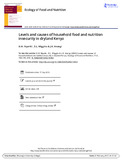| dc.contributor.author | Nyariki, Dickson M. | |
| dc.contributor.author | Wiggins, S.L. | |
| dc.contributor.author | Imungi, J.K. | |
| dc.date.accessioned | 2017-02-25T07:55:28Z | |
| dc.date.available | 2017-02-25T07:55:28Z | |
| dc.date.issued | 2002 | |
| dc.identifier.uri | http://hdl.handle.net/123456789/221 | |
| dc.identifier.uri | http://www.tandfonline.com/doi/pdf/10.1080/03670240214493 | |
| dc.identifier.uri | https://www.researchgate.net/publication/248930944_Levels_and_Causes_of_Household_Food_and_Nutrition_Insecurity_in_Dryland_Kenya | |
| dc.identifier.uri | http://erepository.uonbi.ac.ke/handle/11295/10627 | |
| dc.identifier.uri | http://repository.mut.ac.ke:8080/xmlui/bitstream/handle/123456789/221/Levels%20and%20causes%20of%20household%20food%20and%20nutrition%20insecurity%20in%20dryland%20Kenya.pdf?sequence=1&isAllowed=y | |
| dc.description.abstract | Ensuring food and nutrition security in the drylands of sub-Saharan Africa is a critical challenge. Often, information on the level of insecurity is either scanty or unavailable. This paper looks at food and nutrition access at the household level and its determinants in two cases in one of the sub-Saharan African countries: Kenya. Data were collected from a repeat-visit survey of 50 households in two areas of Makueni District, located in the southern part of the country, during 1994–1996, a period that included ‘normal’ and drought seasons. Even in a season of normal rains, 32 to 42 per cent of households were food insecure, percentages that rose to 40 and 52 during drought. The annual incidence of food poverty was higher (46%) in the drier area than in the wetter area (36%). Food distribution among households, however, showed a reverse trend with the drier area having a Gini coefficient of 0.32 compared to 0.34 in the wetter area. Regressions were used to examine the causes of food and nutrition insecurity. Amongst the main factors improving food and nutrition security was earnings from off the farm. Households headed by women were more food secure than those headed by men, all other things being equal. These findings provide support for prioritising entitlements in terms of earnings and food prices in policy-making, rather than focusing on food production alone. They also indicate that there may be higher social returns to addressing issues of livelihoods associated with women rather than men | en_US |
| dc.language.iso | en | en_US |
| dc.subject | food security | en_US |
| dc.title | Levels and causes of household food and nutrition insecurity in dryland Kenya | en_US |
| dc.type | Article | en_US |

